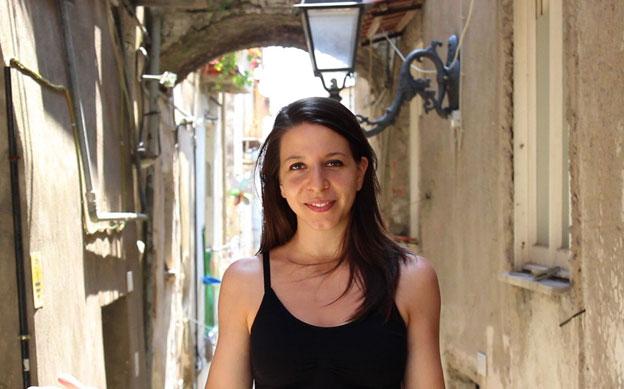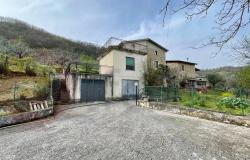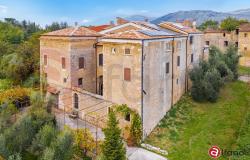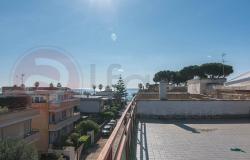Italian-American Mickela Mallozzi is a classically trained dancer and musician who decided to ‘dance’ her way back to her roots in Italy. Inspired by folk dances, she quit her job as assistant to one of the world’s most famous metal rock bands (Slipknot) to start a journey around the world, taking her camera with her to follow dance in the lives of everyday people wherever she went. It does not surprise us that the first stop in her dancing journey was the town her family comes from: Minturno, in the province of Latina (Lazio).
Mickela first recorded and shared her experience in a blog which has turned into a travel web series, Bare Feet™ Web Series , about different ways people celebrate together around the world, with a focus on dance, music and traditional culture.
We talked to her about the experience in Minturno, to understand how it inspired her to continue ‘experiencing the world, one dance at a time!’
When did you discover your passion for dancing and what were your first "steps" into the dance world?
I’ve been dancing since I can remember, and I started formal training at the age of three. My body just naturally can’t stay still if I hear music. I’m also a musician, so for me, dance and music go hand-in-hand naturally: without music, you wouldn’t have dancing, and dancing is an expression that in a lot of cultures affects the musical style. They are a perfect pair.
As a classically trained dancer, how did your interest in folk dancing begin?
I am first generation Italian-American, so I grew up attending a lot of traditional Italian holidays, festivals, and celebrations where women and men were dressed in beautiful costumes and dancing to folk songs of my family’s heritage. It’s a rare and wonderful thing to know where you come from, and I feel extremely privileged to be able to pinpoint exactly where my roots are from, especially as an American.
What inspired you to create your Bare Feet™ project?
My freshman year of college, I took my first solo international trip to meet a friend in Scotland. I was attending a wedding, and as part of the entire weekend’s festivities, the bride and groom organized Scottish reel dance lessons for all of the Americans attending. The lesson was in an old barn, and I had never had so much fun – I wanted to keep having that experience over and over again. After that trip, I studied abroad for two summers following (Florence and Rome), and I continued to travel every summer after that. I caught the travel bug. And in all of my personal travels, I would seek out holidays and festivals; I would approach complete strangers, asking them to dance with me and teach me what moves they were doing. I wanted to replicate that same feeling I had in the Scottish barn, and I have. It’s been an amazing journey, and I feel so lucky to be able to combine both of my passions of travel and dance together in this one project.

How do you plan your visits and your dance lessons?
I usually try and plan my trips around some sort of holiday or celebration, i.e. Carnival, Diwali, or any other particular festival. Then once I decide when and where I’m going, I reach out to friends to see if anyone knows dancers or musicians in that particular destination. I have connected with friends of friends of friends who have been amazing dance guides in the cities I have visited. I also reach out to the local tourism boards; no one knows a country better than the people whose job it is to promote it! The tourism boards also can give me insight on the best times to visit regarding holidays and festivals. They can also connect me with dance schools, performers, local celebrities, and also personal friends of theirs that they know are either musicians or dancers. I like to showcase all sides of music and dance from the grandiose to the local gems.
You have already visited many countries, including the U.S. Virgin Islands, Estonia, France, Argentina, Ireland and Italy, but as you have Italian roots, was the Italian experience any special?
Of course! When I decided to actually start the Bare Feet™ project back in 2010, I realized that before trying to discover other cultures’ dance and music heritage, I had to rediscover my own family’s dance roots first. I hired a few friends of mine to help me document the annual Sagra Delle Regne (Wheat Harvest Festival) in my family’s hometown of Minturno, Italy – this was the beginning for Bare Feet™. We stayed in my grandmother’s farmhouse, and that first trip really set the tone for how Bare Feet™ was going to continue – showing authentic experiences without the fluff. I was able to dance with the local folk troupe and perform in the festival. It was extremely emotional for me, as I had visited Minturno many times before that, but never had I immersed myself in the culture this way before. From there, I took my experience I had in Minturno with my family and friends and I continue that journey of self-discovery everywhere else I go. It’s pretty magical and transformative.
For a dancer being fit is part of the job, how did you manage the eating and cooking with Nonna with the dancer's diet? What is the Italian secret to a healthy approach to food?
I’m not the healthiest eater, or rather, I AM the healthiest eater. I absolutely love food, which isn’t always the best thing for a dancer. But surprisingly, when I’m traveling abroad, I usually lose weight, either because the food is fresher and less processed, or also because of the amount of stress during filming. When I visit these places, I only have a limited amount of time, and I’m usually shooting the entire day without many breaks. But the Italian diet is wonderful because Italians eat in season. Whatever is growing during that time of the year, specific dishes are prepared to reflect that. And that is the natural way to eat – here in America, we are used to getting all produce 365 days of the year. But that’s not always a good thing. Italians still shop at local food markets, even in the big cities, so you know your food is fresh. They shop more often and buy less (shopping for what they need to last them for about two days). The fresh food makes a big difference. Also, eating out less also makes a huge difference – with such simple and fresh ingredients, anyone can make a delicious meal!
What does "dancing" represent for the people of Minturno?
For Minturnesi, la tarantella is a dance that represents joy and happiness, and it is done during any celebration. But I think that goes for most cultures – dance is a way to express joy and prosperity within a community. It brings people together in a way that cannot be replicated by other means. There is proximity in dancing, including touching and holding hands and raising each other’s heart rates just by moving and smiling and creating energy together. It is infectious and a lot of times it is used as a form of healing both mentally and physically. And I see the transformation that dance does not only for the people of Minturno, but also for all cultures worldwide.

Is the local youth interested in learning about folk dances, do these traditions have a future?
Yes, definitely. In Minturno, there is a youth dance group that continues the traditions of la tarantella Minturnese: they are taught the songs of La Sagra Delle Regne, they dress in traditional costume, and they even learn the original dialect from the area. Luckily, there are also worldwide folk festivals that are organized by individual countries and cities that host these international youth dance groups, giving purpose to maintaining and educating the younger generations of folk traditions. These festivals then showcase the groups around the world, giving these youth groups not only the opportunity to perform and preserve their own cultures, but also an incredible opportunity to travel and see the world. A great example of one of these festivals is Europeade, the largest European folk dance and music festival held annually, and it is hosted in different country every year.
How is this project influencing your academic dancing?
Dance has a story and a personality, and when I started dancing as a kid, my stories were limited to the classroom and the ballet studios. I was lucky to have had an amazing ballet teacher, Dieter Riesle (who I still train under today). His approach to dance is not just about aesthetics but also about history, why people dance, and the evolution of these movements. When I travel abroad and learn these folk dances, I’m not only learning how these movements feel to my body, but I’m also learning the stories that come from these movements and why people do them. Dance is an historical tradition, much like storytelling and folk songs. And from these movements, I’m also learning human history which then translates to the evolution of dance. For example, Irish step dance came from sean nós (Irish for “old style”) dance, which immigrated to the Appalachian Mountains in the United States during the Potato Famine, which then became clogging and flatfooting, eventually evolving into tap dancing when it moved up north to New York. It is incredible to see and FEEL the movements evolving with each historical and geographical change.
Are you planning to come back to Italy to learn about other dances and traditions? What other dances would you like to know more about?
I would love to head to Naples to learn la tammurriata and maybe head up north to find the different styles there (more influenced by Switzerland, Austria, etc.). I also just visited the Puglia region, and I learned la pizzica, which is one of the oldest dance traditions in Italy. I’m proud to say that I have partnered with Walks of Italy to create the Bare Feet™ Tour in Bari that not only includes a tour of the historical center of the city, but also a dance and music workshop of la pizzica right in the heart of Bari. And if you want to experience la pizzica for yourself while you are in Italy, check out our Bare Feet™ Tours!
Website: http://travelbarefeet.com
YouTube: http://YouTube.com/travelbarefeet














